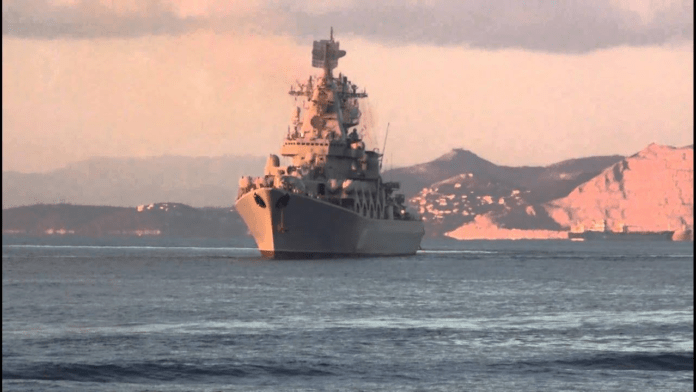Defense Foreign Affairs
Special Analysis
Founded in 1972. Formerly Defense & Foreign Affairs Daily Volume XL, No. 21 Friday, April 15, 2022
| Lessons Learned |
Initial Strategic Lessons of the Russia-Ukraine War
Analysis. By GIS/Defense & Foreign Affairs Staff, with input from our Kyiv correspondent.
I he ongoing Russia-Ukraine war — even as part of a much larger strategic conflict — has already begun to yield significant lessons for statecraft and military operations. [I]
The conflict was far from resolved during April 2022.But regardless of the completion of that military phase, profound and durable changes had been caused to the global architecture.
US Pres. Joe Biden, while ramping up support for Ukraine, said that the US would not interfere with a Russian attempt to militarily resolve its problems with Kyiv. Then Washington kept insisting that Russia was in the process of a “full-scale invasion”. The war had not, even by mid-April 2022, reached the level of a “full-scale invasion”, as dramatic as the imagery of this (or any other) war may be.1
The result was that when Moscow took the bait, Washington was able to irrevocably divide the world once again into two camps, with Russia forced into an alliance with the People’s Republic of China (PRC) and Iran. This will have long-term negative consequences for Russia, as well as for the West (including the US), but has saved the Communist Party of China (CPC), which now has long-term stability in food and energy supply from Russia.“
For those who still cannot comprehend why Vladimir Putin took the bait, the important question should be asked as to why, strategically, Joe Biden offered it. So, even if motive cannot be immediately understood, the best course of action is to reject such temptations.
- Information dominance (ID) warfare, which pre-determined the conduct of the Ukraine conflict, runs the risk that the perpetrators will unwittingly buy their own propaganda. US-led ID ops ascribed motives and goals to Russian planners which clearly were not those determined by Moscow. As a result, Western analysis deceived itself at a public and policy level that Russia had militarily failed in its theater objectives by early April 2022. The actual Russian failure was in its misunderstanding of Washington’s ability to use ID to drive the irrevocable polarization of the West against Russia, and to rebuild the perceived validity of the North Atlantic Alliance.
Russia by mid-April 2022 was close to achieving its goals of securing the defense of Crimea, consolidating and expanding the territorial control of the entire once-Russian area of Donbas (Luhansk and Donetsk), and possibly acquiring a coastal land corridor between the Donbas and Crimea (therefore securing total domination of the Sea of Azov and the surrounding resource regions), while ensuring that post-conflict Ukraine would not be a partner in NATO. The grand strategic cost of the campaign however proved that Moscow may achieve a pyrhhic victory.
- In the current phase of modern technology, countermeasures and defenses have not yet caught up with, or balanced, offensive capabilities. Russia used some key new technologies with impunity in military operations against Ukraine. These, particularly, included hypersonic weapons. To the extent used thus far, however, none of these were war-winning weapons, and it is probable that even a Russian use (doubtful) of tactical nuclear weapons would materially impact the outcome of the conflict. Nonetheless, it is clear that the use of new-technology offensive weapons has given considerable impetus to the evolution of anti-hypersonic countermeasures, for example, which may be viable within a year or more.
What was clear was, however, the reality that the capabilities of unmanned aerial vehicles in an offensive role had still far from peaked, and that — as Ukraine demonstrated on April 13, 2022 — shore-based anti-shipping missiles, coupled with reconnaissance and electronic warfare assistance from UAVs (Turldsh-built Bayraktar TB-2) were difficult to detect and deter. This is a key lesson for those contemplating operations in, say, the Red Sea, Persian Gulf/Arabian Sea (Strait of Hormuz), and South and East China seas regions. Significantly, Iran has Ukrainian- sourced anti-shipping cruise missile batteries on its coastline; Vietnam and the Philippines have acquired Indo-Russian supersonic BrahMos anti-shipping batteries.

Significantly, although the Moskva was extensively modernized since its initial delivery in 1979, and was operated by an experienced crew, it clearly was functioning too close to the Ukraine coastline, possibly to avoid being in international waters with the possibility of contact with foreign warships, and was insufficiently prepared for a mass EW assault on its sensors. Ironically, the ship had been presented with what was purported to be a fragment of the Cross of Jesus Christ, and this holy relic was kept aboard as a blessing and a token of good luck. It had cost the donor a reported $40-million. There was no immediate news as to whether the relic had been saved.
All 510 crew aboard Moskva were, however, saved, but the loss of the Russian Black Sea Fleet flagship — the largest warship to be lost in combat since World War II (the other capital ship loss was the Argentine Navy light cruiser, Belgrano, 12,242 tons (full load disp.), lost in 1982 — was a severe political blow for Russia.
Footnotes:
- “Surviving the First Shot of Cold War II”, in Defense & Foreign Affairs Special Analysis,March 28. 2022.
This report noted, among other lessons, that “Russia demonstrated that strategic nuclear doctrine could be updated in a way which permitted a very large spectrum of conventional warfare beneath a nuclear threshold. Instead of the First Cold War doctrine that conventional direct military contact between nuclear powers would act as a tripwire guaranteeing escalation to nuclear contact, the Russians used the threat of nuclear escalation to enable a high degree of conventional military warfare with the denial of access to that war by foreign forces supporting Ukraine. This was a reversal of First Cold War practice, and showed new utility in the deterrent and prestige realities of nuclear weapons.”
- “How Ukraine Has Saved Communist China”, in Defense & Foreign Affairs Special Analysis,March 7,
2022.
[I] Anything your adversary (a) wants you to do, (b) goads you to do, (c) offers to you as a gift, or (c) says you will do is almost certainly something you do not want to do.
Russian Pres. Vladimir Putin took the bait on ail four counts in deciding to attack Ukraine. The US Government had, since late 2021, insisted that Russia was about to invade Ukraine, at a time when Moscow had no plans to do so (even though it had increasingly used the threat of force to keep Ukraine out of NATO). Then, on January 25, 2022,




